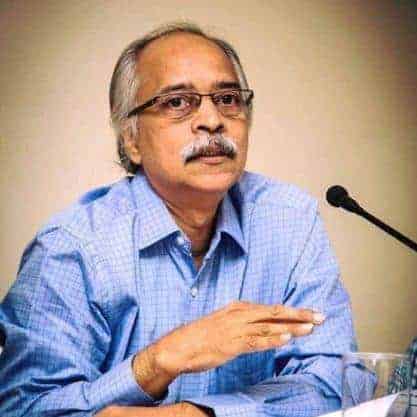
The month of August, saw two leadership changes in two unique Institutions in India, located in Hyderabad—The Centre for DNA Fingerprinting and Diagnostics (CDFD) and the Earth System Science Organisation -Indian National Centre for Ocean Information Services (ESSO-INCOIS).
Dr K Thangaraj, a distinguished researcher, with a well recognised track record of work in population and medical genetics has taken over the reign of the CDFD, a national Laboratory under the Union Department of Biotechnology (DBT).
The CDFD was born out of the Centre for Cellular & Molecular Biology (CCMB). It was a constituent lab of the Centre for Scientific and Industrial Research (CSIR) in 1990, which in turn was spun out of the Regional Research Laboratory (RRL), Hyderabad and inaugurated by Prime Minister, Rajiv Gandhi in 1987.
After being housed temporarily at the CCMB, Nacharam and M J Market areas in rented buildings, it’s now moved into its own, upcoming campus in Uppal.
Dr Thangaraj, has done most of his pioneering work on the applications of the DNA fingerprinting technology at the CCMB, under the leadership of Dr Lalji Singh, who is considered the pioneer in establishing the technique of DNA fingerprinting in India.
Interestingly, Thangaraj was one of the main experimental scientist who carried out the critical analysis of DNA samples ( Deoxyribonucleac acid) at the CCMB, where several cases of paternity, crime and scientific research were undertaken in the 1980s and 1990s.
Thereafter, assessing the growing potential of DNA fingerprinting as an application tool, the then Director of CCMB, Dr P M Bhargava, the DBT and the CSIR decided to spin it off as a separate Centre of Excellence. Most of the preliminary work had been done at the CCMB by Dr Lalji Singh, Thangaraj and a strong team.
Lalji Singh was the OSD for several years from the inception of CDFD, before Syed Hasnain, took over as the first Director in 1998. Thereafter, the lab had Dr J Gowrishankar and Debasis Mitra since 2017 as full-fledged directors.
In addition to a body of work on ‘Population Genetics’, focussed on the origins of the Andaman and Nicobar islanders, their links to Africa ( considered the cradle of civilisation) and to mainland Indians, Thangaraj and Lalji Singh have done work on certain genetic diseases in the Indian populations.
Of these, the work in coronary heart diseases and genetic factors influencing and role of Mitochondrial genes in certain diseases, like those related to human teeth are some of the ongoing research contributions of Dr Thangaraj. He brings, decades of experimental knowledge to drive the growth of the CDFD.
The CDFD has been recognised as an important centre for providing testing for COVID-19 since April itself for Telangana. In a recent study, it showed that asymptomatic persons carry much higher load than symptomatic cases and may be the reason for the fast transmission of the infection in the country.
ESSO-INCOIS:
Think Tsunami and the first name that comes to mind is the Earth System Science Organisation (ESSO) -INCOIS, Hyderabad which is the nodal agency in India for warning against any potential tsunami. It has developed a full-fledged warning systems and has established a 24/7 Tsunami Warning Centre and Service.
The December 26, 2004 Tsunami wrecked havoc in Tamil Nadu, Andaman and Nicobar Islands and a few other parts in India. It was triggered by the massive 9.1 magnitude Tremblor off the coast of Sumatra in Indonesia.
INCOIS, established as an Autonomous Institute under the Ministry of Earth Sciences in 1999 was led by Dr K Radhakrishnan and several scientists from the National Remote Sensing Agency (NRSA), Hyderabad joined. It was initially housed in a private building in Nandagiri layout in Jubilee Hills.
Along with Radhakrishnan, the first Director, who later became the Chairman of the ISRO, was Dr T Srinivasa Kumar. The INCOIS was making an impact with its advisory on Potential Fishing Zones (PFZ), which helped fishermen maximising their catch and minimise time and risks at sea. The advisory gave potential locations where ‘Schools of fish’, gathered based on remote sensing imagery and interpretation by the scientists.
Sometime during the middle of 2001, I had a chance to cover an event at the INCOIS, where the then Secretary, Ministry of Earth Sciences. Dr Harsh K. Gupta, was the Chief Guest. I first met, Dr Radhakrishnan, Srinivasa Kumar and team, who were giving shape to the research activities of the Centre and continued to report developments over time.
On August 28, Srinivasa Kumar, took over as the Director of ESSO-INCOIS for a five-year term, in the new and expanded Institute campus in Nizampet. From the rented Nandagiri Hills, the Institute has journeyed into one with international recognition too.
“Proud to see the founding team at the helm now. Best wishes”, tweeted Radhakrishnan K Koppili on the development. Srinivasa Kumar, who has made extensive contributions in ocean studies and tsunami, moved to the Intergovernmental Coordination Group for the Indian Ocean Tsunami Warning and Mitigation System (ICG/IOTWMS), with its Secretariat based in Perth, Australia around 2009-10.
Srinivasa Kumar took charge from Dr T M Balakrishnan Nair, who was in-charge director after the retirement of S S C Shenoi, earlier this year. One of the earlier directors, Dr Shailesh Nayak (2006-08), became Secretary, Ministry of Earth Sciences and served during (2008- 2015). During his tenure, the Tsunami Warning Centre was established in INCOIS.
Somasekhar Mulugu, former Associate Editor & Chief of Bureau of The Hindu BusinessLine, is a well-known political, business and science writer and analyst based in Hyderabad.

